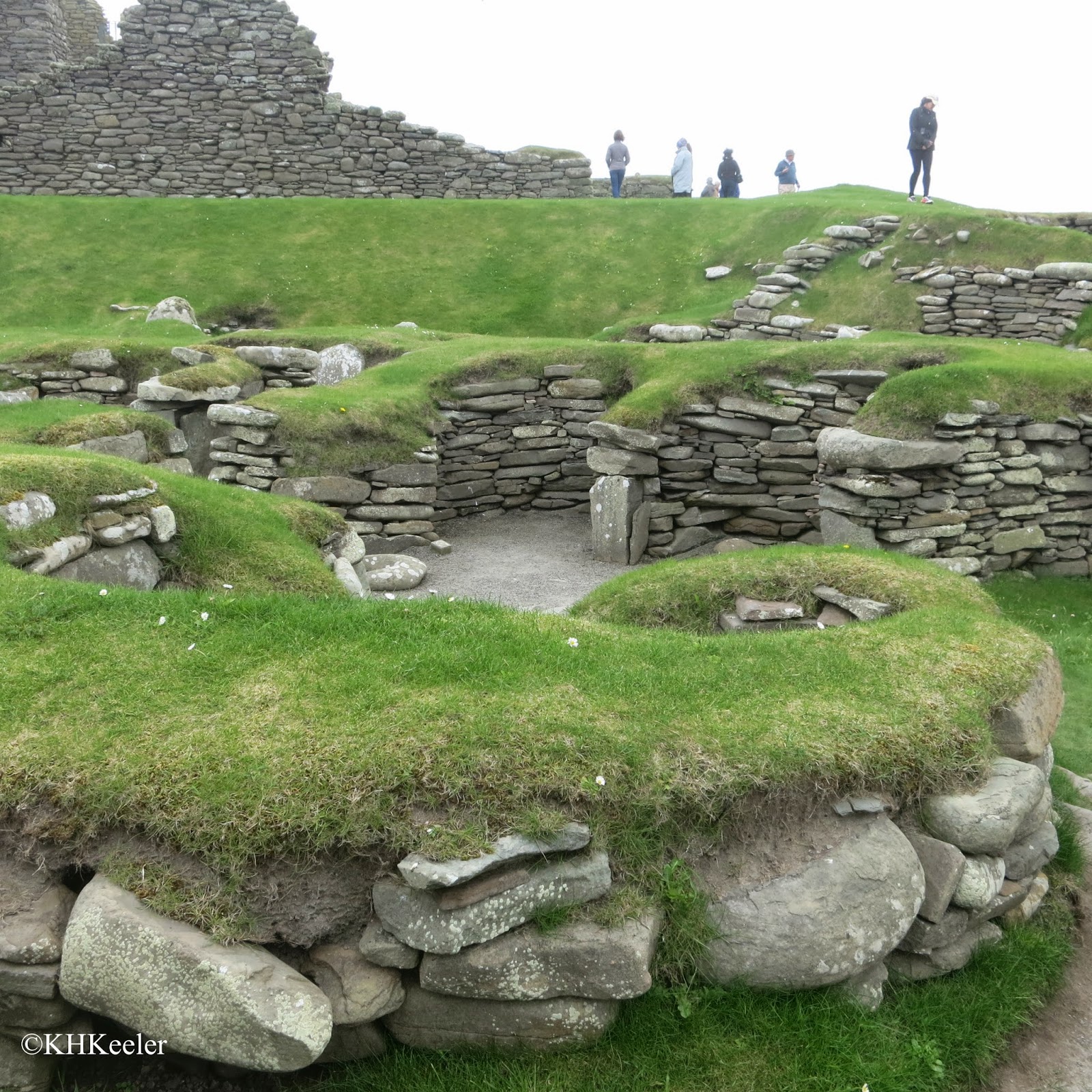On Shetland I visited Jarlshof. Here, the brutal Earl Patrick Stewart built a fortified manor on the same site as a 800 BC Bronze-age village.
Today nobody lives there, but the ruins and artifacts are from the Neotlithic (2500-1500 BC), then Bronze Age, Iron Age, Pict, Norse and Scots' settlements! (link)
The name, Jarlshof, is not ancient but rather conferred because Sir Walter Scott found the place romantic and used it as the site of his 1822 novel The Pirate. At that time part of the structure was apparently still habitable. The older name for the area was Sumburgh. Jarlshof and Sumburgh are practically at the southern tip of the Shetlands' main island, called Mainland. (That name makes references to places very confusing, until you catch on.)
 |
| Ruin of the earl's manor house, Jarlshof, Shetland |
Typical of the area, abandoned settlements were hidden by the turf. Strong storms at the end of the 19th century tore off the turf, revealing layer upon layer of settlement.
The Bronze Age ruins feature a smithy that was in use around 800 BC. The smith worked at a hearth set next to a flagstone-covered sand pit for cooling his molds, in the lowest, central spot below. He used metalworking techniques also known in Ireland at about that time, which makes you think the Shetlanders were not isolated but part of a complex wider community.
Around the work areas, both in the Bronze and later, were stone rooms. These would have been above the ground at the time and covered with sod roofs. The floors and walkways were paved and the Iron Age inhabitants built souterrains, underground stone-lined storage chambers.
Improvements in technology steadily made larger, more comfortable houses. The "windows" in my photos were used for storage, as were various stone boxes set in the floor.
Around the settlements were pastures for cattle and sheep. From the Bronze Age, settlers raised wheat and barley. However, much of the food was wild, for example, birds and gathered plants, and seals, fish, shellfish from the sea.
Weaving was apparently unknown until the Iron Age--no spindle whorls or weaving tools were found at the Bronze Age levels.
People appear to have lived at Jarlshof pretty continuously, so that later Iron Age settlements overlie early Iron Age settlements, probable Pict settlements have earlier and later phases and the Norse settlement built and rebuilt across the area.
Greater fortifications were built, including a multi-storied tower (broch) around the time of Christ, and then larger more complex houses, followed by the arrival of the Norse, who built a longhouse and later a medieval farm. In 1469 Norway gave Shetland to Scotland in lieu of a cash dowery for Princess Margaret of Denmark and Norway when she married King James III of Scotland and the Earls of Shetland arrived. The second earl is believed to have built the house that became the ruin called Jarlshof by Scott.
There was so much to take in, so much complexity of the ways different people lived. And despite all they could tell me about it, there were many times the answer was "nobody knows." My imagination eagerly tried to visualize people living their lives in these dwellings, with all the daily concerns of people everywhere--hunting, fishing, caring for cattle and sheep, planting and harvesting grains and gathering wild plants, making tools and preparing food, and also finding romance, touching the unknown through religion, creating things of beauty, often jewelry, playing games and sports and making music. All of this must have been there, different in different eras, but similar because it is the stuff of human daily life.
The North Sea is threatening the Jarlshof site. The coast was substantially farther away when the prehistoric people lived there and sea has been eroding the coast ever since. Probably part of the prehistoric villages have already been destroyed by the ocean.
We read about global climate change and rising sea levels in the abstract. It happens slowly. But prehistoric (and historic and modern) people liked to live near the seas. What was a "safe distance inland" is changing as sea levels rise. Only rarely can anyone stop the encroachment of the sea, so there is a critical need to save the artifacts. But without context, a stone quern or bronze bowl doesn't tell us much. Thus, careful excavation of archaelogical sites before the sea destroys them is urgently needed. Go and see these endangered sites--while you can!--and you will understand. Donate to the study of coastal archaelogy (anywhere in the world!). Or, make it an adventure and volunteer for a week or a month at a project to map, categorize and preserve archaeological artifacts. (Some sources for such programs: Archaelogical Institute of America, working holiday, Scotland, UK volunteers, One World 365
A beautiful, fascinating, ancient place, Shetland.
Comments and corrections welcome.
The tour was organized by Academic Arrangements Abroad and Travel with the Met. Previous post on Shetland (link).
The tour was organized by Academic Arrangements Abroad and Travel with the Met. Previous post on Shetland (link).
Kathy Keeler
More at awanderingbotanist.com
Join me on Facebook: https://www.facebook.com/AWanderingBotanist







Scotland is beautiful place for spending your holidays. I was there couple of times. Recently, I went to France, quite romantic place. Loved it so much!
ReplyDeleteroad trip france